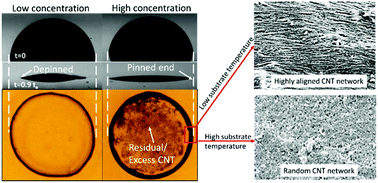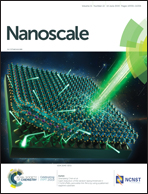Sessile droplets containing carbon nanotubes: a study of evaporation dynamics and CNT alignment for printed electronics
Abstract
Carbon nanotubes (CNTs) are 1-dimensional (1D) and flexible nanomaterials with high electric conductivity and a high aspect ratio. These features make CNTs highly suitable materials for the fabrication of flexible electronics. CNTs can also be made into dispersions which can be used as the feedstock material for droplet-based 3D printing technologies, e.g., inkjet printing and aerosol jet printing to fabricate printed electronics. These printing techniques involve several physical processes including deposition of ink droplets on flexible polymeric substrates such as polyimides, evaporation of the solvent and formation of thin films of CNTs, all of which have not been thoroughly investigated. Besides, alignment of the CNTs in the resultant thin films dictates their electrical performance. In this work, we examine the effect of substrate temperature and CNT concentration on the evaporation dynamics and also the alignment in the deposition patterns. Evaporation-driven self-assembly of CNTs and their preferential alignment are observed. Image analysis and Raman spectroscopy are utilised to evaluate the degree of alignment of the CNT network. It is found that the contact line dynamics depends greatly on the CNT concentration. Besides, the substrate temperature plays a significant role in determining the order of the CNTs in the drying deposition pattern. Our findings show the possibility of controlling the film morphology and the degree of alignment of CNTs for printed electronics in the printing process.



 Please wait while we load your content...
Please wait while we load your content...